Disabled Bodies, Disabled Ways of Thinking
An Interview with Hanna Cormick
BY EMMALY WIEDERHOLT; PHOTOS BY SHELLY HIGGS
Hanna Cormick is an Australian performer who worked in Australia, Europe and Asia for 15 years as a physical theater actress, dancer and circus performer before becoming afflicted with a series of severe genetic disorders. She recently premiered her first piece since becoming disabled. The Mermaid explores themes of isolation and non-renewable resources. She shares her experience building The Mermaid and her new perspective on ability.
~~
What is your history in performance and theater?
I worked professionally as a physical theater actress, dancer and circus performer over a period of 15 years. Six years ago, I underwent further training at L’École Internationale de Théâtre Jacques Lecoq in Paris, after which I worked in a series of theater shows in France and the UK, as well as performing cirque-cabaret with Apollo Garcia at Les Douleurs Exquises in Paris and Turkey. My work aimed for physical perfection and virtuosity. Using my body was my primary mode of expression.
Can you tell me about your condition and how it developed?
About three years ago, my body started deteriorating. It was what we later found out to be a cluster of rare genetic disorders: I have a severe form of Hypermobile Ehlers-Danlos Syndrome, Mast Cell Activation Syndrome, Chiari Malformation and Dysautonomia. These disorders affect all my organs and also cause many secondary issues, such as spinal instability, seizures and episodic paralysis.
For a long time, I didn’t know what was going on. I was just very sick. I became allergic to everything around me, and started experiencing injuries and severe pain. I lost a lot of weight and couldn’t walk any distance without becoming exhausted. My body was completely falling apart. It became so bad that it reached the point where I was no longer able to care for myself, so I had to return to Australia to be cared for by my family. That’s when the endless doctor appointments and hundreds of tests began. It took years of searching, but we finally came upon these diagnoses.
You recently premiered The Mermaid, your first performance since becoming afflicted with your conditions. What was the impetus for the piece, and what was the process developing it?
For a long time, I assumed I would never be able to perform again, nor even be involved in art at all; the act of creating involves levels of energy I no longer possess. My conditions are incurable, and my body had permanently changed in ways I didn’t know how to process. I was ashamed of these changes. I didn’t want people to know.
My final performance before I quit acting was at the Edinburgh Fringe. While there, in my state of increasing illness, I was drawn to go see a lecture organized by Sick of the Fringe, entitled “Better Dead Than Disabled,” featuring the wheelchair-using actress Liz Carr. Part of her speech was about the social model of disability. It was the first time I’d been exposed to the concept that it’s not one’s body that makes one disabled; it’s the social, cultural and environmental structures. When I became a wheelchair user myself, I clung to that message to help me navigate all the internalized ableism and shame I was now confronting.
That understanding of disability was the first seed of the idea for The Mermaid. In the ocean, a mermaid is free, but by changing her environment, she is presented as disabled. It’s not a fault with the body or the person that causes these issues.
Another thing that caught my eye during Liz’s lecture were her outrageously beautiful stiletto boots, the sort an able-bodied person would have serious trouble walking in. Being able-bodied at the time, I didn’t yet know that wheelchairs are a freedom, and not a prison as our culture makes them out to be, but I suddenly saw how, in that instance, her chair gave her the sartorial upper hand, how she’d turned it into an object of power. When I became a wheelchair user, I started thinking about how I could transform my wheelchair into a visual asset, to flip people’s idea of it as something sad or pitiful. The image I present when I’m in public is already bizarre; I have to wear a full-face respirator, which is a bit like a gas mask, an oxygen tank, and body braces. I wanted to push that further, into something artistic and captivating. I finally settled on the idea of the mermaid. It was fantastical and fabulous, something people couldn’t look away from.
Illness is hidden away by our culture; we don’t like to be reminded of the fragility of our own bodies. I’ve experienced people trying to hide or invalidate me just to push away that discomfort. I wanted to make what was happening to me visible, and to speak up for my right to be seen. There are so many people being made invisible by mainstream culture, not just the chronically ill and disabled, but anyone living with difference: people who are LGBTQI, refugees, or homeless. The different barriers these groups face are all part of the same injustice: people whose existence is culturally denied as a means of denying their basic rights.
That extends to the planet, and the way we willfully ignore the damage that’s being done through the climate crisis, trying to not see the impacts from the way we live. We are not separate from that damage. Small actions of others, the way we pollute shared resources like the air, can have a huge medical impact upon me. In The Mermaid, my body is a mirror for the sickness of the earth. There is this whole world of things that are being made invisible, and are being hurt by that invisibility; I wanted people to stop looking away.
Visibility became the method to address my own shame. I knew that hiding would only mutate it. I needed an act of high visibility to burn it out. The social model of disability teaches that shame is an internalization of the ableist messages in our society. There is nothing shameful about bodies with difference, but there’s this cultural narrative that a disabled life is worth less than an able-bodied life. Whether you are able-bodied or disabled, we’ve all grown up in a world that tells us there is something wrong with disabled bodies, that people with a disability should be pitied, that they should be given charity instead of equity, that their situation is worse than others.
And there are difficulties with this life. I’m in a lot of pain, all the time. The isolation is really hard. But the biggest obstacle people with disabilities face is not our bodies, but the way society treats us, and the way spaces and cultural structures are designed explicitly without us in mind.
The theater, dance and circus industries fetishize ability. I did. I equated ability to talent, and I believed that I could overcome anything by working hard enough. When I became disabled, it required a complete mental overhaul. I realized how damaging and self-exploitative my ideas and methods of working had been. It brought up for me the image of a fossil fuel company draining and destroying the planet. I had thought I could mold my body to my own ends, as if it were simply a resource to serve me.
I could no longer do the things I was known for. Even so, I tried. I thought I could create something virtuosic. You see that a lot in disability-based dance and circus; it focuses on what the body can still do despite the disability. That’s the mindset I went into this creation with, still dragging these ability-centric ideas behind me. I choreographed a wheelchair dance routine, hoping to somehow prove that all my training still had purpose.
Then, the mermaid costume arrived. I am allergic to most materials, so the tail had to be made of pure silicon, which is incredibly heavy, and I was too weak to move with it on. I had to ask: “What do I have to offer apart from the ability of my body?” It forced me to move beyond technique and virtuosity. I realized I had something to say.
The mermaid exists in a liminal space. I became a bridge between the invisible and visible, speaking from that hidden world. My personal story became the narrative. My physical restrictions and my medical symptoms became my choreographic language. The unpredictability of my illness became my structure.
I knew doing this performance carried the risk of triggering a reaction which could develop into a seizure, so I needed to make that possibility part of the work. I am susceptible to severe reactions to contaminants within the air: the scent of food and drink, perfume, clothing, makeup, hair products, smoke… almost anything can trigger an allergic reaction. I use protective devices, but they are not enough, so it is a medical risk to be in public. And this is exactly what happened during the first performance. I immediately began having a seizure, and my collaborator, Christopher Samuel Carroll, blasted a track by The Everly Ills and held up signs explaining to the audience that I was having an allergic reaction and why. That was how that particular performance began.
What was the general response to the performance?
I’m told that during the seizure was exceptionally uncomfortable. I guess that’s part of what I wanted – not to make people uncomfortable for the sake of it, but to look at something that is, by its very nature, uncomfortable. Sometimes we must let ourselves sit in discomfort to see what’s really going on.
Throughout the text-based sections of the performance, the audiences were attentive, very reserved and still. It’s difficult to describe; it was a different energy than I’ve encountered before. Afterwards, many people reached out to me and explained how confronting they found the work. One touching phrase from a director I used to work with was: “the most soul-pulverizing performance I have ever seen.”
Some people were less receptive. During one of my seizures, I had been lowered onto a patch of gravel beside a busy crosswalk. A festival volunteer became agitated and frightened, and kept asking what needed to be done. Christopher and our assistant, Lucy, assured her that it was under control and would pass, but she was so uncomfortable with my visible sickness that she felt the need to make up her own artistic rationale, cheerily yelling to passersby that my convulsions were an artwork about mermaids out of water, trying to masquerade the medical reality as purely performative. I understand the impulse, but when you’re trying to enhance visibility of uncomfortable issues, that’s not the action of an ally.
Did you feel like any of the press you received was problematic in its language or assumptions?
Yes, it’s a big issue that the disability community often talks about. It’s called inspiration porn, and it frames disability as something that someone has overcome, for the explicit purpose of inspiring or motivating the able-bodied. Stephen Hawking died in the days before my performance. The narrative in the articles about him were how he was brilliant “despite” his disability and medical conditions, how he was “confined” to a chair, and how he “overcame” his disability to do his work. I found that language problematic.
In my press, there were hints of me overcoming my disability, but it was most prevalent in the way people wrote about me on social media. I saw words like “brave, courageous and inspiring” used to describe me, which I found quite difficult to take on. There’s bravery and courage involved in making art, but that’s true for all artists.
There’s this kind of de-professionalizing of work created by disabled artists. The focus had shifted away from my work and onto the barriers I faced to create it. Though this is an important discussion – we cannot dismantle those barriers to access without discussing them, and disability visibility and advocacy are certainly a part of my work – when the media focus is more on my disability than on the art itself, I feel like I am no longer viewed as a professional, but rather that my work is seen as outsider art. There’s an implicit notion that being disabled precludes one from being a professional artist. And maybe it’s my ego that rebels against that box, that needs to keep being seen as professional, but I feel there are some thorny conversations about recognition and validity that are wrapped up in it too.
But it’s a double-edged sword. Resources for people with disabilities tend not to be given as a recognition of structural inequalities, but as a kind of charity in which disabled people must prove they are disabled enough to deserve those resources. It’s a situation where people with disabilities are forced to rely upon that sense of pity just to confront the huge privilege gap. We do face more hurdles, and we have less access and opportunity, so sometimes, as artists, we have to lean on that hint of inspiration story in order to get anywhere.
What are your performance goals going forward?
This work was my coming out as being disabled. I hadn’t told a lot of people, particularly in the arts community. Having made myself so visible through the performance and publicity was confronting, but the work itself helped me keep going. Though the vulnerability required for these kinds of visible actions is challenging, I’m hungry to pursue where it takes me as an artist.
I’m interested in developing choreography for my chair into cabaret-burlesque work, to challenge the perception of disabled bodies as asexual. Apollo and I have mused about reprising our old duo in this new frame. I’m also interested in engaging in disability activism. In going through this, it was other people who have been vocal about their struggles who really saved me by reframing my perspective.
Any other thoughts?
We don’t do anything alone. Apart from the tireless support team I had around me, the organizations that assisted were invaluable in the realization of my work. Art, Not Apart worked very hard to make the festival a space I could access, even allowing me to be part of the conversation on where they placed food stalls to prioritize my safety. Belconnen Arts Centre offered me a mini artist residency where I could use their venue for rehearsal outside of hours, so I could be kept away from other people and triggers. These were supports that were grounded in the understanding that certain spaces and resources are traditionally inaccessible to disabled bodies, and specifically to my disabled body, and that certain accommodations need to be made, as an equitable redressing of that imbalance, if we want to experience the work of disabled artists in a professional sphere.
~~

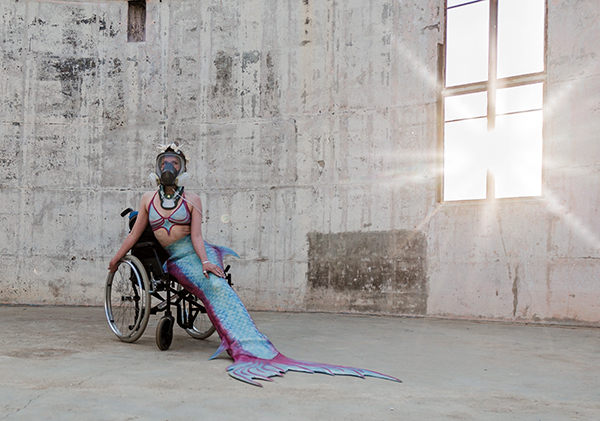
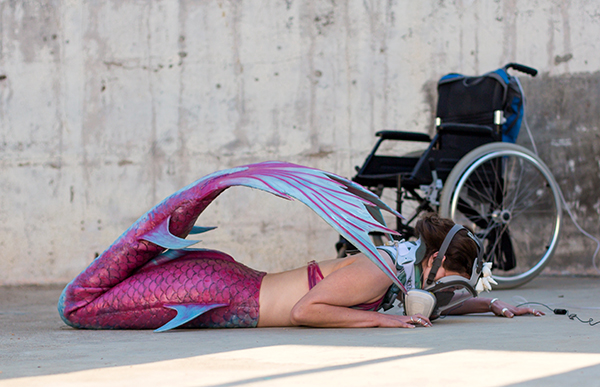
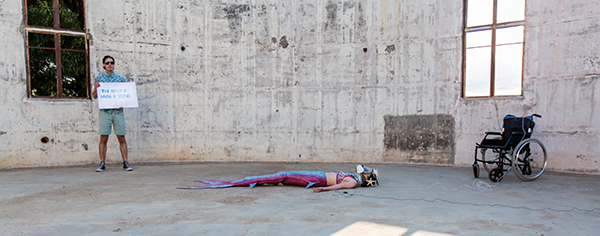
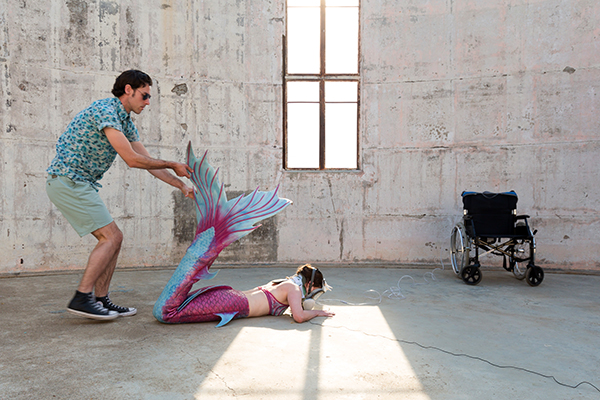
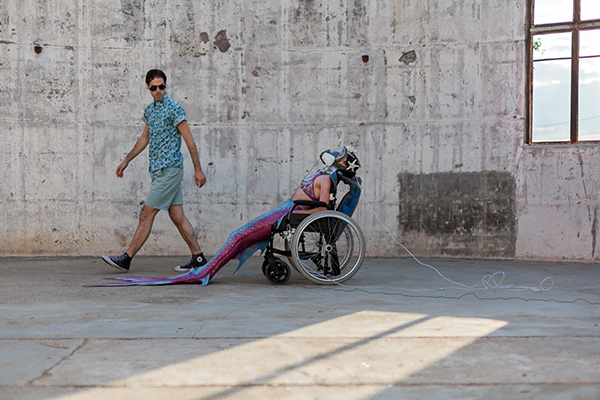
One Response to “Disabled Bodies, Disabled Ways of Thinking”
I never thought I would find someone like you/me. I’m not a dancer but I have been a musician/singer for my whole life. I started having problems with bipolar disorder when I was younger and managed to cope. The got a job at a large chemical company and was exposed to some extremely toxic chemicals which sensitized my airway; so now the smallest amount of certain chemicals can set me choughing and choking and spitting/throwing up. This causes me to have to wear a half mask respirator in public and sometimes even is my own house. It is a major social obstacle, new friends, girl friend… most likely not gonna happen. I have a little cute 12 pound dog that goes everywhere with me. My dog is the perfect buffer for the people that think I’m some kind of threat. I think some people want to make things right. Most people however aren’t ever going to understand. I’m struggling really hard with music and losing my ability to perform in a public setting. Singing with a gas mask on is not easy and I have been trying to make it work. When I saw your story I just couldn’t believe someone had somewhat similar experiences to me. I love you in the purest sense of the word and I hope you are able to accomplish all of your goals! 🙂
Comments are closed.